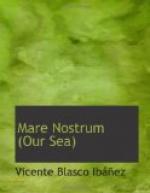The abyssal deeps have two floors or roofs. In the highest, is the so-called neritic zone,—the oceanic surface, diaphanous and luminous, far from any coast. Next is seen the pelagic zone, much deeper, in which reside the fishes of incessant motion, capable of living without reposing on the bottom.
The corpses of the neritic animals and of those that swim between the two waters are the direct or indirect sustenance of the abyssal fauna. These beings with weak dental equipment and sluggish speed, badly armed for the conquest of living prey, nourish themselves with the dropping of this rain of alimentary material. The great swimmers, supplied with formidable mandibles and immense and elastic stomachs, prefer the fortunes of war, the pursuit of living prey, and devour,—as the carnivorous devour the herbivorous on land,—all the little feeders on debris and plancton. This word of recent scientific invention presented to Captain Ferragut’s mind the most humble and interesting of the oceanic inhabitants. The plancton is the life that floats in loose clusters or forming cloud-like groups across the neritic surface, even descending to the abyssal depths.
Wherever the plancton goes, there is living animation, grouping itself in closely packed colonies. The purest and most translucent salt water shows under certain luminous rays a multitude of little bodies as restless as the dust motes that dance in shafts of sunlight. These transparent beings mingled with microscopic algae and embryonic mucosities are the plancton. In its dense mass, scarcely visible to the human eye, float the siphonoforas, garlands of entities united by a transparent thread as fragile, delicate and luminous as Bohemian crystal. Other equally subtle organisms have the form of little glass torpedoes. The sum of all the albuminous materials floating on the sea are condensed in these nutrient clouds to which are added the secretions of living animals, the remnants of cadavers, the bodies brought down by the rivers, and the nourishing fragments from the meadows of algae.
When the plancton, either by chance or following some mysterious attraction, accumulates on some determined point of the shore, the waters boil with fishes of an astonishing fertility. The seaside towns increase in number, the sea is filled with sails, the tables are more opulent, industries are established, factories are opened and money circulates along the coast, attracted thither from the interior by the commerce in fresh and dried fish.
If the plancton capriciously withdraws itself, floating toward another shore, the marine herds emigrate behind these living meadows, and the blue plain remains as empty as a desert accursed. The fleets of fishing boats are placed high and dry on the beach, the shops are closed, the stewpot is no longer steaming, the horses of the gendarmerie charge against protesting and famine stricken crowds, the Opposition howls in the Chambers, and the newspapers make the Government responsible for everything.




